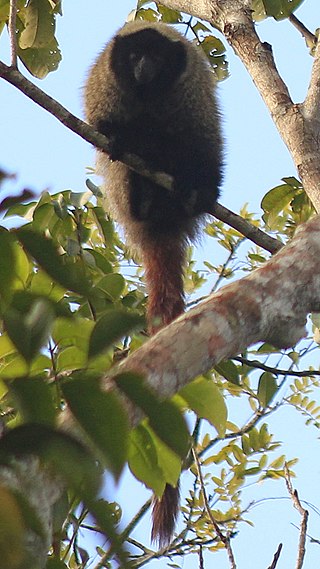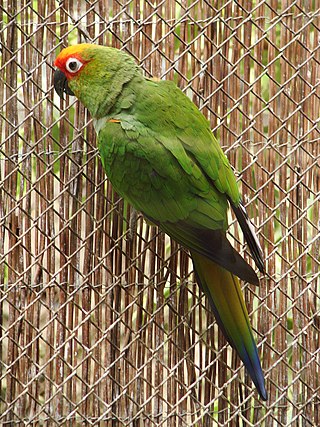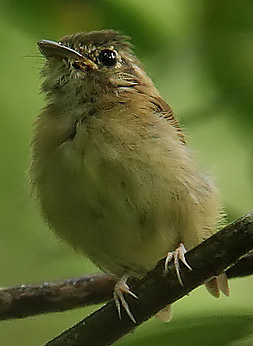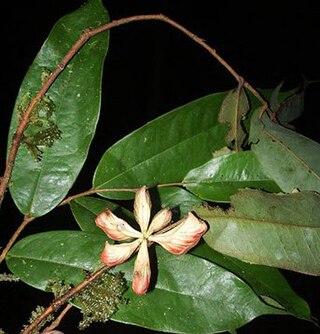
Paubrasilia echinata is a species of flowering plant in the legume family, Fabaceae, that is endemic to the Atlantic Forest of Brazil. It is a Brazilian timber tree commonly known as Pernambuco wood or brazilwood and is the national tree of Brazil. This plant has a dense, orange-red heartwood that takes a high shine, and it is the premier wood used for making bows for stringed instruments. The wood also yields a historically important red dye called brazilin, which oxidizes to brazilein.

Ficus citrifolia, also known as the shortleaf fig, giant bearded fig, Jagüey, wild banyantree and Wimba tree, is a species of banyan native to southern Florida, the Caribbean, Mexico, Central America, and northern South America south to Paraguay. It is distinguished from the closely related Florida strangler fig mainly by the finer veining in the leaves.

Coimbra Filho's titi monkey or just Coimbra's titi is a species of titi, a type of New World monkey, endemic to forests in the Brazilian states of Bahia and Sergipe. It was first discovered by Shuji Kobayashi. It is considered one of the most endangered of all Neotropical primates. It is named after Adelmar F. Coimbra-Filho, founder and Former Director of the Rio de Janeiro Primate Centre, in honor of his work in the field of Brazilian primatology and biology.

Dendropsophus branneri is a small hylid tree frog endemic to the Atlantic Forest region of Brazil. It feeds mainly on arthropods and is preyed upon by various invertebrates and vertebrates. Although currently classified by the IUCN Redlist as "least concern", D. branneri suffers rapid habitat loss due to residential development, agriculture, logging, and clearing for pastureland. Male D. branneri are noted for their fighting call, which differs significantly in frequency, duration, and pulses per call compared to their mate advertisement call. Males are also noted for their willingness to escalate physical altercations against other males, which includes kicking, pushing, and wrestling their opponent into non-dominant positions. Unlike most other frog species, D. branneri can breed in both temporary and permanent pools allowing it to inhabit a wide variety of habitats leading to its wide distribution.

The golden-capped parakeet is a species of parrot in the family Psittacidae found in Brazil and Paraguay. Its natural habitats are subtropical or tropical dry forest, subtropical or tropical moist lowland forest, dry savanna, and plantations. It is threatened by habitat loss. The A. auricapillus is a good biological indicator because of its vulnerability, high detectability as well as its sensitivity to forest fragmentation.

The stub-tailed spadebill is a passerine bird in the Tyrannidae family. It is commonly found in tropical dry rainforests or tropical moist lowlands throughout Central America. First scientifically described in 1860, it was originally thought to be the same as Platyrinchus mystaceus but was later reclassified as a sympatric species. The stub-tailed spadebill may grow up to 9.5 cm (3.74 in) long and may weigh up to 12 g (0.42 oz). It has a white throat, yellow breast, and brown mantle and wings. The stub-tailed spadebill is most easily recognizable due to its stubby tail, broad bill, and its distinctive bird song. Some morphological differences like its greatly reduced crown differentiate it from other related species.

The big bonneted bat, or Dabbene's mastiff bat is a species of bat in the family Molossidae, native to South America. It is named for a former conservator at the Buenos Aires National Museum.

Ficus aurea, commonly known as the Florida strangler fig, golden fig, or higuerón, is a tree in the family Moraceae that is native to the U.S. state of Florida, the northern and western Caribbean, southern Mexico and Central America south to Panama. The specific epithet aurea was applied by English botanist Thomas Nuttall who described the species in 1846.
Ficus maxima is a fig tree which is native to Mexico, Central America, the Caribbean and South America south to Paraguay. Figs belong to the family Moraceae. The specific epithet maxima was coined by Scottish botanist Philip Miller in 1768; Miller's name was applied to this species in the Flora of Jamaica, but it was later determined that Miller's description was actually of the species now known as Ficus aurea. To avoid confusion, Cornelis Berg proposed that the name should be conserved for this species. Berg's proposal was accepted in 2005.

Ficus insipida is a common tropical tree in the fig genus of the family Moraceae growing in forest habitats along rivers. It ranges from Mexico to northern South America.

Ficus americana, commonly known as the West Indian laurel fig or Jamaican cherry fig, is a tree in the family Moraceae which is native to the Caribbean, Mexico in the north, through Central and South America south to southern Brazil. It is an introduced species in Florida, USA. The species is variable; the five recognised subspecies were previously placed in a large number of other species.

The Castilleae are a tribe within the plant family Moraceae. It includes eight to 11 genera and 55–60 species including Castilla, the Panama rubber tree.

Annona aurantiaca is a species of plant in the family Annonaceae. It is native to Brazil. João Barbosa Rodrigues, the Brazilian botanist who first formally described the species, named it after its orange colored petals.

Annona dioica is a species of plant in the family Annonaceae. It is native to Bolivia, Brazil and Paraguay. Augustin Saint-Hilaire, the French botanist who first formally described the species, named it after its flowers which have different reproductive structures and.

Annona jahnii is a species of plant in the family Annonaceae. It is native to the Brazil, Colombia and Venezuela. William Edwin Safford, the American botanist who first formally described the species, named it after the Venezuelan scientist, explorer and mountain climber Alfredo Jahn.
Diclinanona calycina is a species of plant in the family Annonaceae. It is native to Brazil, Colombia, Peru and Venezuela. Ludwig Diels, the German botanist who first formally described the species using the basionym Xylopia calycina, named it after its well-developed calyx.

Fusaea longifolia is a species of plant in the family Annonaceae. It is native to Brazil, Colombia, Ecuador, French Guiana, Guyana, Peru, Suriname and Venezuela. Jean Baptiste Christophore Fusée Aublet, the French botanist who first formally described the species using the basionym Annona longifolia, named it after its long-leaved foliage.
Pseudochapsa aptrootiana is a species of corticolous (bark-dwelling) in the family Graphidaceae. Found in Brazil, it was formally described as a new species in 2018 by Marcela Eugenia da Silva Cáceres, Thamires Almeida Pereira, and Robert Lücking. The type specimen was collected from Mata do Cipó at an elevation of 80–100 m (260–330 ft); here, in an Atlantic Rainforest remnant, it was found in the forest understory. It has a light grey thallus lacking a prothallus and a cortex. Its ascospores, which number eight per ascus, are oblong to spindle-shaped (fusiform) with between 11 and 15 septa and measure 30–35 by 7–8 μm. Lichen products that occur in Pseudochapsa aptrootiana include stictic and constictic acid as major or submajor metabolites, and minor to trace amounts of cryptostictic, hypostictic, and acetylhypoconstictic acids. The species epithet honours Dutch lichenologist André Aptroot, "for his invaluable contributions to tropical lichenology".

Uvariopsis congolana is a species of plant in the Annonaceae family. It is native to Cameroon, the Democratic Republic of the Congo, Gabon, and the Republic of the Congo. Émile De Wildeman, the botanist who first formally described the species using the basionym Thonnera congolana, named it after the Belgian Congo now called the Democratic Republic of the Congo, where the specimens he examined were collected near Makanza and Yambuya.

Xylopia cuspidata is a species of plant in the Annonaceae family. It is native to Bolivia, Brazil, Colombia, Ecuador and Peru. Ludwig Diels, the botanist who first formally described the species, named it after the leaves which have an abruptly pointed tip.


















